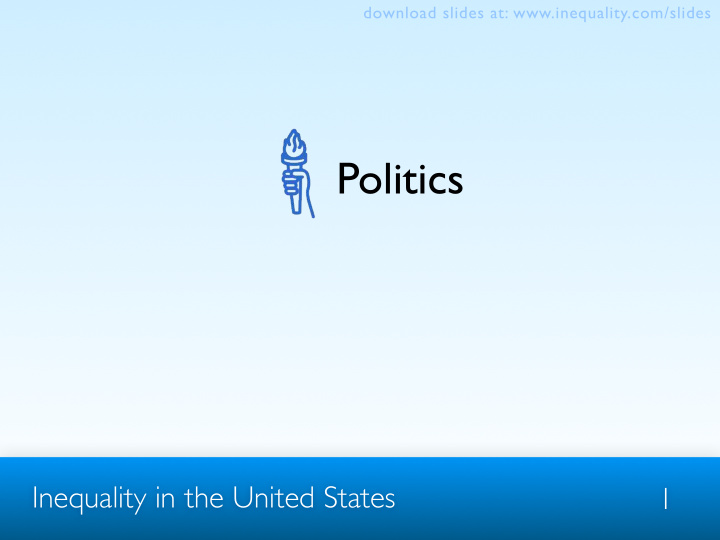



download slides at: www.inequality.com/slides Politics Inequality in the United States 1
download slides at: www.inequality.com/slides Politics Political Participation and Income This figure contrasts six 90.0 kinds of political activity under $15,000 across two income groups - $75,000 and over families earning below 67.5 $15,000 and those above Percent Active $75,000. For the most 45.0 part, the American poor participate much less in politics than do those with 22.5 higher incomes , a difference that is especially stark when looking at who contributes 0 Campaign Affiliated w/ Voting Campaign Contact Protest to campaigns. Work Political Organization Contribution Type of Political Participation Source: This figure is adapted from Sidney Verba, Kay Schlozman and Henry Brady’s book, Voice and Equality: Civic Voluntarism in American Politics, pg. 190. Inequality in the United States 2
download slides at: www.inequality.com/slides Politics Senator Responsiveness to Constituent Income This chart displays senator responsiveness and constituent 7 101st Congress income. It shows that senators’ roll 102nd Congress call votes are much more responsive 103rd Congress 6 to the political preferences of middle Senator Responsiveness and high income constituents than 5 they are to low-income constituents. 4 In addition to participating less in politics, the poor are also less likely to 3 have their preferences represented by their elected representatives. 2 1 0 Source: These graphs represent the result of a regression analysis by Bartels (2008) of constituency opinion on -1 Low Middle High senator’s roll call votes across the 101st, 102nd, and Constituent Income 103rd congresses. Inequality in the United States 3
download slides at: www.inequality.com/slides Politics Income and Political Influence This chart depicts the Questions where Preferences of the 10th and relationship between the 90th Income Percentiles Diverge percentage of an income group that wants political change and .50 Predicted Probability of Change whether or not that political change actually occurs. When .40 policy preferences between 10th percentile income groups diverge, it is the .30 preferences of the rich who get converted into actual policy. .20 The more the wealthy (90th 90th percentile percentile in terms of income) .10 desire change, the more likely it is for political change to occur. .00 0% 20% 40% 60% 80% 100% Source: Gilens, Martin. 2005. Inequality and Democratic Responsiveness. Public Opinion Percent Favoring Change Quartlerly 69 (5): 778-796. Inequality in the United States 4
download slides at: www.inequality.com/slides Politics Political Awareness, Ideology, and Perceptions of Income Inequality This chart illustrates the relationship 1.0 between political ideology, general political Liberals 0.9 awareness, and perceptions of income inequality. The more politically aware 0.8 (horizontal axis) a Liberal is the more likely Probability of Agreement 0.7 she is to recognize that income inequality has increased (vertical axis). By contrast, 0.6 Conservatives the more politically aware a Conservative 0.5 is, the less likely she is to recognize that income inequality has increased. 0.4 0.3 0.2 0.1 0.0 0 10 30 60 70 80 90 100 20 40 50 Source: Bartels, L.M. 2008. Unequal democracy: The political Political Awareness Percentile economy of the new gilded age. Princeton University Press. Inequality in the United States 5
download slides at: www.inequality.com/slides Politics Income growth by Percentile under Democratic and Republican Presidents 1948-2005 This graph depicts income growth for the American population under Democratic 3.0 and Republican administrations. Under Democrats Average annual growth in real income (%) Democratic presidents, poorer families’ 2.5 incomes grew at a slightly higher rate than those of more wealthy families, producing a 2.0 small net decrease in income inequality. Under Republican Administrations, the rich did significantly better than the poor, 1.5 leading to a large increase in inequality. 1.0 Republicans 0.5 0.0 0 10 30 60 70 80 90 100 20 40 50 Source: Bartels, L.M. 2008. Unequal democracy: The political Income Percentile economy of the new gilded age. Princeton University Press. Inequality in the United States 6
Inequality in the United States Contributors Kendra Bischoff Education kendrab1 @ stanford.edu Anmol Chaddha Debt achaddha @ fas.harvard.edu Erin Cumberworth Mobility ecumberw @ stanford.edu Sharon Jank Gender sjank @ stanford.edu Carly Knight Politics crknight @ fas.harvard.edu Bridget Lavelle Health blavelle @ umich.edu Krystale Littlejohn Race & Ethnicity klittlej @ stanford.edu Lindsay Owens Wealth lowens @ stanford.edu David Pedulla Employment dpedulla @ princeton.edu Kristin Perkins Poverty kperkins @ fas.harvard.edu Sharon Jank Income sjank @ stanford.edu Ariela Schachter Immigration arielas1 @ stanford.edu Jordan Segall Violent Crime jsegall @ stanford.edu Chris Wimer Family cwimer @ stanford.edu download slides at: www.inequality.com/slides download slides at: www.inequality.com/slides
Recommend
More recommend